Specifications Hyundai Genesis Coupe 2013 Owner's Manual
[x] Cancel search | Manufacturer: HYUNDAI, Model Year: 2013, Model line: Genesis Coupe, Model: Hyundai Genesis Coupe 2013Pages: 414, PDF Size: 38.89 MB
Page 285 of 414
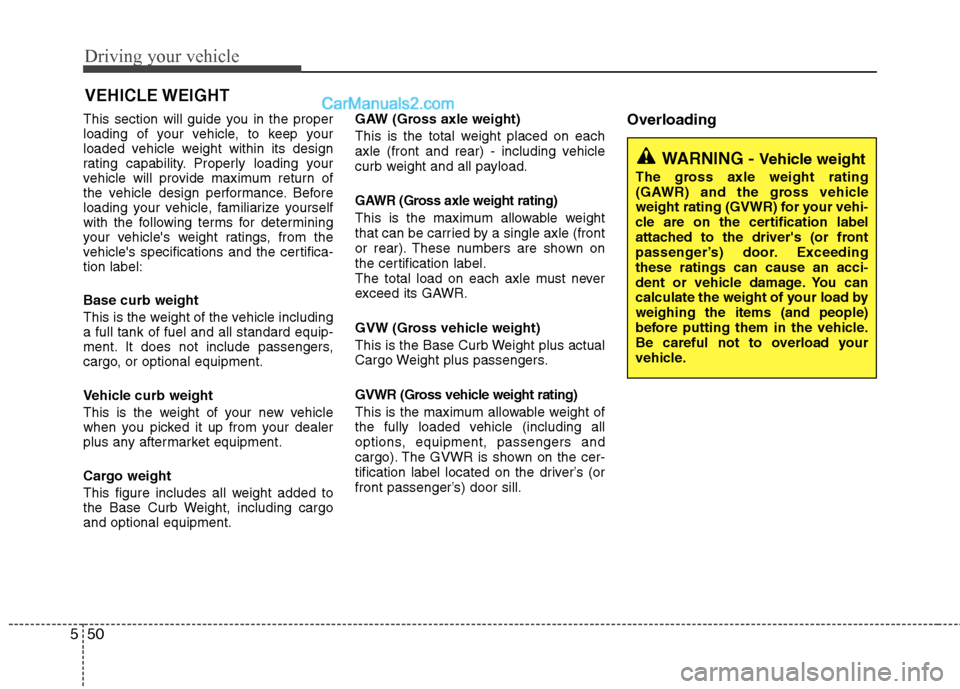
Driving your vehicle
50
5
This section will guide you in the proper
loading of your vehicle, to keep your
loaded vehicle weight within its design
rating capability. Properly loading your
vehicle will provide maximum return of
the vehicle design performance. Before
loading your vehicle, familiarize yourself
with the following terms for determining
your vehicle's weight ratings, from the
vehicle's specifications and the certifica-tion label: Base curb weight
This is the weight of the vehicle including a full tank of fuel and all standard equip-
ment. It does not include passengers,
cargo, or optional equipment.
Vehicle curb weight
This is the weight of your new vehicle
when you picked it up from your dealer
plus any aftermarket equipment.
Cargo weight
This figure includes all weight added to
the Base Curb Weight, including cargoand optional equipment. GAW (Gross axle weight)
This is the total weight placed on each
axle (front and rear) - including vehicle
curb weight and all payload.
GAWR (Gross axle weight rating)
This is the maximum allowable weight
that can be carried by a single axle (front
or rear). These numbers are shown on
the certification label.
The total load on each axle must never
exceed its GAWR.
GVW (Gross vehicle weight)
This is the Base Curb Weight plus actual
Cargo Weight plus passengers.
GVWR (Gross vehicle weight rating)
This is the maximum allowable weight of
the fully loaded vehicle (including all
options, equipment, passengers and
cargo). The GVWR is shown on the cer-
tification label located on the driver’s (or
front passenger’s) door sill.
Overloading
VEHICLE WEIGHT
WARNING -
Vehicle weight
The gross axle weight rating
(GAWR) and the gross vehicle
weight rating (GVWR) for your vehi-
cle are on the certification label
attached to the driver's (or front
passenger’s) door. Exceedingthese ratings can cause an acci-
dent or vehicle damage. You can
calculate the weight of your load byweighing the items (and people)
before putting them in the vehicle.
Be careful not to overload your
vehicle.
Page 360 of 414
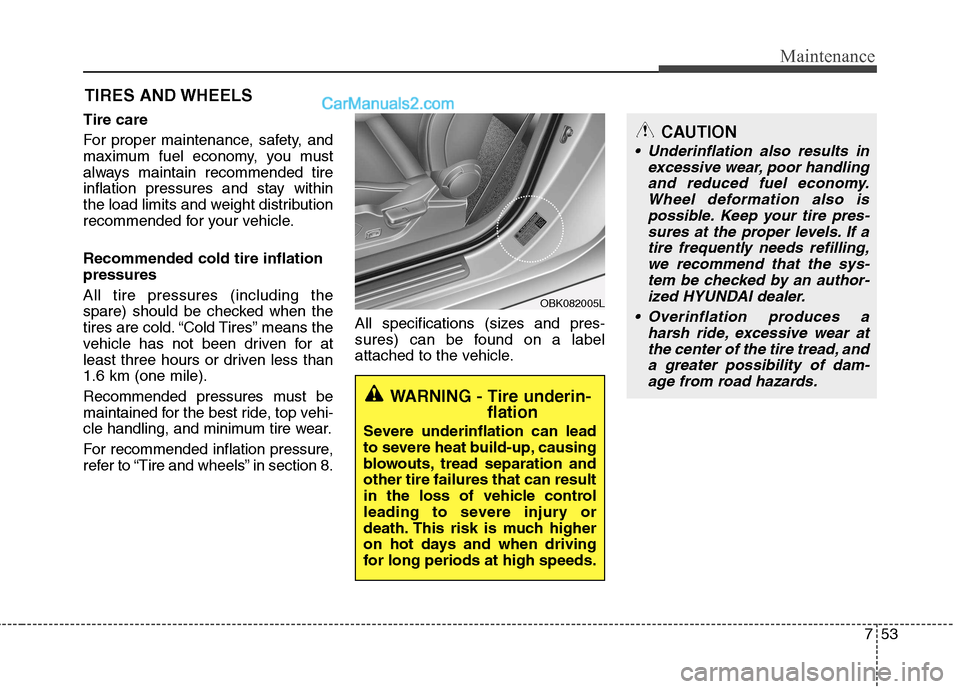
753
Maintenance
TIRES AND WHEELS
Tire care
For proper maintenance, safety, and
maximum fuel economy, you must
always maintain recommended tire
inflation pressures and stay within
the load limits and weight distribution
recommended for your vehicle. Recommended cold tire inflation pressures All tire pressures (including the
spare) should be checked when the
tires are cold. “Cold Tires” means the
vehicle has not been driven for at
least three hours or driven less than1.6 km (one mile).
Recommended pressures must be
maintained for the best ride, top vehi-
cle handling, and minimum tire wear.
For recommended inflation pressure,
refer to “Tire and wheels” in section 8. All specifications (sizes and pres-
sures) can be found on a label
attached to the vehicle.
WARNING - Tire underin-
flation
Severe underinflation can lead
to severe heat build-up, causing
blowouts, tread separation andother tire failures that can result
in the loss of vehicle control
leading to severe injury or
death. This risk is much higher
on hot days and when driving
for long periods at high speeds.
OBK082005L
CAUTION
Underinflation also results in excessive wear, poor handlingand reduced fuel economy. Wheel deformation also ispossible. Keep your tire pres-sures at the proper levels. If a tire frequently needs refilling,we recommend that the sys-tem be checked by an author- ized HYUNDAI dealer.
Overinflation produces a harsh ride, excessive wear atthe center of the tire tread, anda greater possibility of dam- age from road hazards.
Page 365 of 414

Maintenance
58
7
Compact spare tire replacement
(if equipped)
A compact spare tire has a shorter
tread life than a regular size tire.
Replace it when you can see the
tread wear indicator bars on the tire.The replacement compact spare tire
should be the same size and design
tire as the one provided with your
new vehicle and should be mountedon the same compact spare tire
wheel. The compact spare tire is notdesigned to be mounted on a regular
size wheel, and the compact spare
tire wheel is not designed for mount-
ing a regular size tire. Wheel replacement
When replacing the metal wheels for
any reason, make sure the new
wheels are equivalent to the original
factory units in diameter, rim widthand offset.
✽✽
NOTICE
The front tire size is different from
the rear tire size. So when you rotate
tires, check the tire and wheel size.
(Continued)
Using tires and wheel other than the recommended sizes
could cause unusual handling
characteristics and poor vehi-
cle control, resulting in a seri-ous accident.
Wheels that do not meet HYUNDAI’s specifications
may fit poorly and result in
damage to the vehicle or
unusual handling and poor
vehicle control.
The ABS works by comparing the speed of the wheels. Tire
size can affect wheel speed.
When replacing tires, all 4
tires must use the size origi-
nally supplied with the vehi-
cle. Using tires of a different
size can cause the ABS (Anti-
lock Brake System) and ESP
(Electronic Stability Program)
to work irregularly.
WARNING
A wheel that is not the correct
size may adversely affect wheel
and bearing life, braking and
stopping abilities, handling
characteristics, ground clear-
ance, body-to-tire clearance,
snow chain clearance,speedometer and odometer cal-
ibration, headlight aim and
bumper height.
Page 406 of 414
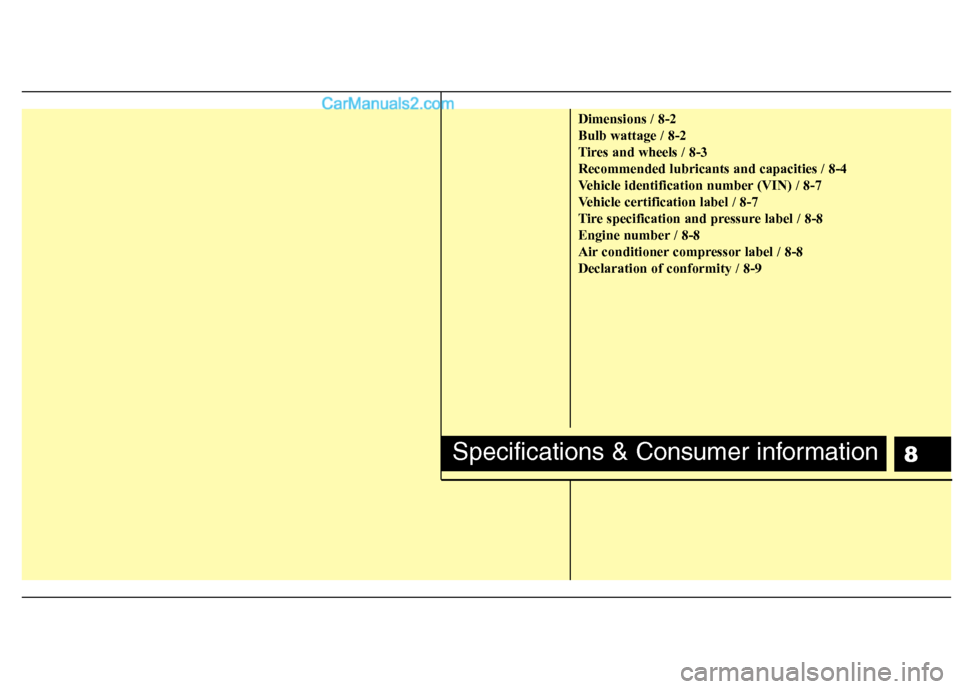
8
Dimensions / 8-2 Bulb wattage / 8-2
Tires and wheels / 8-3Recommended lubricants and capacities / 8-4
Vehicle identification number (VIN) / 8-7
Vehicle certification label / 8-7
Tire specification and pressure label / 8-8
Engine number / 8-8
Air conditioner compressor label / 8-8Declaration of conformity / 8-9
Specifications & Consumer information
Page 407 of 414

Specifications & Consumer information
2
8
DIMENSIONS BULB WATTAGE
Item mm (in)
Overall length 4,630 (182.2)
Overall width 1,865 (73.4)
Overall height 1,385 (54.5)
Front tread 1,605 (63.2) / 1,601 (63.0)*1
Rear tread 1,625 (64.0) / 1,621 (63.8)*1
Wheelbase 2,820 (111)
ENGINE
Item Gasoline 2.0 Gasoline 3.8
Displacement [cc(cu.in)] 1,998
(121.9) 3,778
(230.5)
Bore x Stroke [mm(in)] 86 x 86
(3.38 x 3.38) 96 x 87
(3.78 x 3.42)
Firing order 1-3-4-2 1-2-3-4-5-6
No. of cylinders 4, In-line 6, V-Type
Light Bulb Wattage Bulb type
Headlights (Low) 55 or
35 (HID) H7*
1
Headlights (High) 55 H7LL
Front turn signal lights 21 PY21WLL
Front fog lights 35 H8L
Front position lightsLEDLED
Daytime running lights*LEDLED
Rear fog light* (Driver side only) 21 H21W
Stop and tail lights LED LED
Rear turn signal lights 21 P21WL
Back-up lights 16 W16W
High mounted stop light* LED LED
License plate lights 5 W5WL
Map lamps 10 W10W
Luggage lamp 5 FESTOON
Glove box lamp 5 FESTOON
Vanity mirror lamps* 5 FESTOON
Side repeater lights* LED LED
* : if equipped * 1
: For Europe - H7HPLL
Except Europe - H7LL
*
1
: with R19 tire
Page 408 of 414
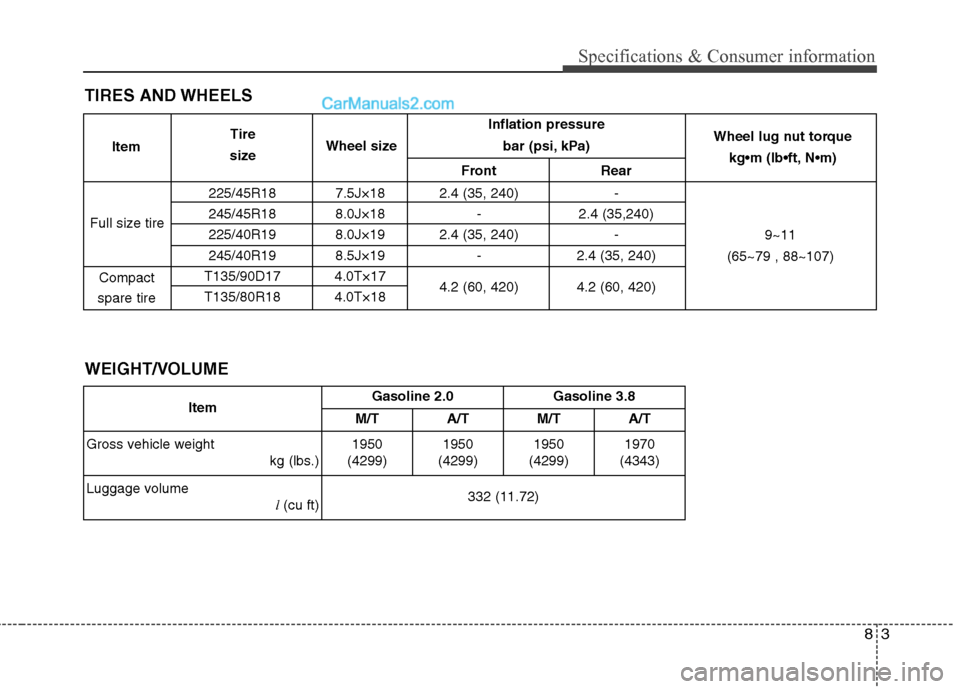
83
Specifications & Consumer information
TIRES AND WHEELS
Inflation pressure bar (psi, kPa)
Front Rear
225/45R18 7.5J×18 2.4 (35, 240) -
245/45R18 8.0J×18 - 2.4 (35,240)
225/40R19 8.0J×19 2.4 (35, 240) -
245/40R19 8.5J×19 - 2.4 (35, 240)
T135/90D17 4.0T×17 4.2 (60, 420) 4.2 (60, 420)
T135/80R18 4.0T×18
Full size tire
Compact
spare tire Wheel lug nut torque
kg•m (lb N
9~11
(65~79 , 88~107)
Item
Tire
size Wheel size
Item Gasoline 2.0 Gasoline 3.8
M/T A/T M/T A/T
Gross vehicle weight kg (lbs.)1950
(4299) 1950
(4299) 1950
(4299) 1970
(4343)
Luggage volume l(cu ft)
332 (11.72)
WEIGHT/VOLUME
Page 409 of 414
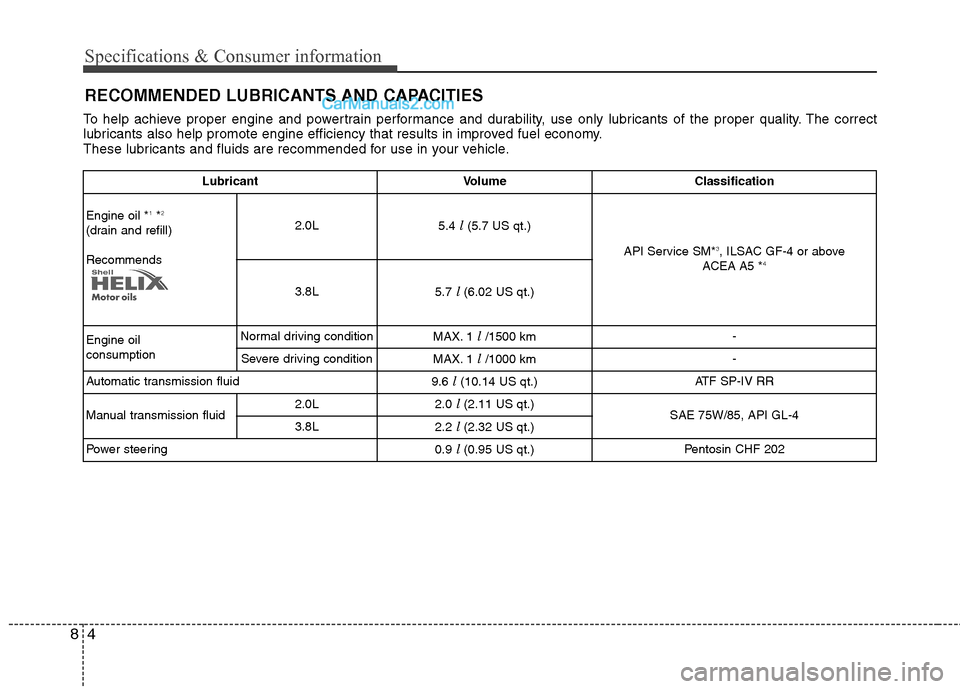
Specifications & Consumer information
4
8
RECOMMENDED LUBRICANTS AND CAPACITIES
Lubricant Volume Classification
Engine oil *1
*2
(drain and refill) Recommends2.0L5.4 l (5.7 US qt.)
API Service SM* 3
, ILSAC GF-4 or above
ACEA A5 * 4
3.8L 5.7l (6.02 US qt.)
Engine oil consumption Normal driving condition
MAX. 1l /1500 km -
Severe driving condition MAX. 1l /1000 km -
Automatic transmission fluid 9.6l (10.14 US qt.) ATF SP-IV RR
Manual transmission fluid 2.0L
2.0l (2.11 US qt.)
SAE 75W/85, API GL-4
3.8L 2.2l (2.32 US qt.)
Power steering 0.9l (0.95 US qt.) Pentosin CHF 202
To help achieve proper engine and powertrain performance and durability, use only lubricants of the proper quality. The correct
lubricants also help promote engine efficiency that results in improved fuel economy.
These lubricants and fluids are recommended for use in your vehicle.
Page 410 of 414

85
Specifications & Consumer information
*1
: Refer to the recommended SAE viscosity numbers on the next page.
* 2
: Engine oils labeled Energy Conserving Oil are now available. Along with other additional benefits, they contribute to fuel economy by reducing
the amount of fuel necessary to overcome engine friction. Often, these improvements are difficult to measure in everyday driving, but in a year’s
time, they can offer significant cost and energy savings.
* 3
: If the API service SM engine oil is not available in your country, you are able to use API service SL.
* 4
: If the ACEA A5 engine oil is not available in your country, you are able to use API service SL IL SAC GF-3, ACEA A3. Lubricant Volume Classification
Coolant
2.0L M/T
6.5l (6.87 US qt.)
Mixture of antifreeze and water
(Ethylene glycol base coolant for aluminum radiator)A/T6.3 l (6.06 US qt.)
3.8LM/T9 l (9.51 US qt.)
A/T 8.8l (9.30 US qt.)
Brake fluid 0.7~0.8l (0.7~0.8 US qt.) SAE J1703, FMVSS116 DOT-3 or DOT-4
Fuel 65l (17.17 US gal.) Refer to “Fuel requirements” in section 1.
Rear differential oil 1.4l (1.48 US qt.) Hypoid gear oil API GL-5, SAE 75W/90
Page 411 of 414

Specifications & Consumer information
6
8
Recommended SAE viscosity
number Engine oil viscosity (thickness) has an
effect on fuel economy and cold weather
operating (engine start and engine oil
flowability). Lower viscosity engine oils
can provide better fuel economy and cold
weather performance, however, higher
viscosity engine oils are required for sat-
isfactory lubrication in hot weather. Using
oils of any viscosity other than those rec-ommended could result in engine dam-
age.When choosing an oil, consider the range
of temperature your vehicle will be oper-
ated in before the next oil change.Proceed to select the recommended oil
viscosity from the chart.
CAUTION
Always be sure to clean the area
around any filler plug, drain plug, ordipstick before checking or drain-ing any lubricant. This is especiallyimportant in dusty or sandy areas
and when the vehicle is used on unpaved roads. Cleaning the plugand dipstick areas will prevent dirt and grit from entering the engine
and other mechanisms that couldbe damaged.
Temperature Range for SAE Viscosity Numbers
Temperature
Gasoline Engine Oil * 1
°C
(°F)-30 -20 -10 0 10 20 30 40 50 -10 0 20 40 60 80 100 120
*1
: For better fuel economy, it is recommended to use the engine oil of a viscosity grade SAE 5W-
30 (API SM/ILSAC GF-4/ACEA A5). However, if the engine oil is not available in your coun-
try, select the proper engine oil using the engine oil viscosity chart.
20W-50
10W-30
15W-40
5W-30, 5W-40
Page 412 of 414
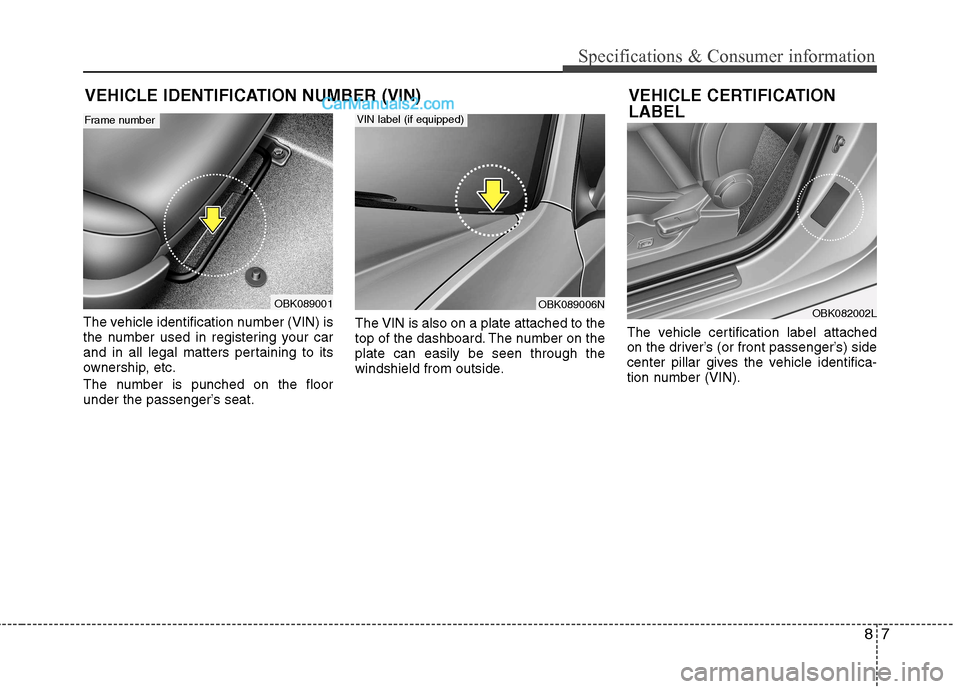
87
Specifications & Consumer information
VEHICLE IDENTIFICATION NUMBER (VIN)
The vehicle identification number (VIN) is
the number used in registering your car
and in all legal matters pertaining to its
ownership, etc.
The number is punched on the floor
under the passenger’s seat. The VIN is also on a plate attached to the
top of the dashboard. The number on theplate can easily be seen through the
windshield from outside.
The vehicle certification label attached
on the driver’s (or front passenger’s) side
center pillar gives the vehicle identifica-
tion number (VIN).
OBK089001
Frame number
OBK082002LOBK089006N
VIN label (if equipped)
VEHICLE CERTIFICATION LABEL